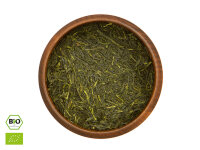
Shincha Tea
Shincha – Japanese Spring Tea
Shincha simply means "new tea" in Japanese. The distinctive feature of Shincha tea is its freshness. It comes from the very first harvest of the year in spring. The foundation for this green tea is the Sencha plant, specifically the first picking. The still small leaves and young buds are characterized by their unique ingredients, which provide health benefits, freshness, and a high nutrient content.
Shincha is also known as "air-flown tea" because it is always transported to us by air freight to preserve its freshness and prevent temperature fluctuations that can occur during sea transport.
This type of tea is processed to retain a higher moisture content of up to 5% in the tea leaves. While this makes green tea less durable, it ensures exceptional freshness and excellent quality.
The Effects of Shincha Tea on Health
Like almost all Japanese green teas, Shincha, derived from Camellia Sinensis, contains numerous components for a healthy impact. These include high concentrations of cell-protecting antioxidants / catechins (EGCG), the amino acid L-Theanine, which promotes well-being, balance, and relaxation, as well as various vitamins (Vitamin A Beta Carotene, Vitamin B1, B2, B3, Vitamin E, and Vitamin K). Metabolism, cardiovascular health, digestive functions, and even memory performance can noticeably benefit. This excellent green tea also has anti-inflammatory properties.
For the full range of health benefits, we recommend drinking various green teas alternately. This way, you can benefit from the different emphases of active ingredients in each type of green tea. Green tea can be enjoyed daily without hesitation.
High-Quality Shincha Tea at ORYOKI
All our organic Shinchas are imported by air to avoid temperature fluctuations and maintain freshness in the tea. Our green teas come from selected tea gardens in Japan. We took our time and compared many green teas from different regions and growing areas in the Land of the Rising Sun for our selection. The combination of quality, organic cultivation, and outstanding taste set the standard for us.
- Shincha Makizone, Organic, First Flush »
- Shincha Kyushu, Organic, First Flush »
- Gensen Tezumi Shincha, Organic, Super Premium »
- KEIKO Shincha Yume, Organic, First Flush »
- KEIKO Shincha Yakushima, Organic, First Flush »
We are currently testing additional selected varieties from Japan, some of which will soon be added to our green tea assortment.
The "Right" Preparation of Shincha Green Tea
There is no universally applicable rule for preparation. There are always guidelines to extract the full flavor from green tea, and the recommendation varies slightly from one type to another. For the dosage, we recommend about a well-filled teaspoon of Shincha per 150 - 200 ml of water. Boiling water should be cooled to around 60 - 70 °C, as otherwise, green tea would lose valuable ingredients and flavors immediately. The steeping time for the first infusion is between 60 - 90 seconds. An overly long steeping time can release many often unpleasant bitter compounds from the tea, which are not desired. For the second and third infusions, the steeping time is significantly shorter, around 10 - 20 seconds.
However, even slight variations in tea preparation can influence the taste in one direction or another. With a bit of experimentation, the tea can be fine-tuned to your personal taste. We recommend slight adjustments in water temperature in 5 °C increments and slightly shorter or longer steeping times.
For full tea enjoyment, we recommend consuming green tea as soon as possible after opening the package. Otherwise, green tea quickly loses its flavor.





Enjoying Shincha, Japanese Style
For tea enthusiasts, especially those for whom green tea plays a significant role, the question of which teapot provides the best tea enjoyment arises relatively quickly. For high-quality green teas, the traditional clay teapot (Kyusu) is the ideal choice. The Yokode Kyusu, with its side handle, is the most commonly used type. In our assortment, you will find a good selection of handcrafted side-handle pots by Japanese masters.
Porcelain teapots, a suitable and beautiful material for this purpose, are also used in Japan. They are often handmade using traditional manufacturing methods. We also offer porcelain teapots from Japan in our assortment. Our green tea pot So-So has received design awards and is a highly decorative representative of the porcelain teapot category. Here, the porcelain is of very high quality, thin, and slightly transparent.
The black cast iron teapots Arare and Hira Arare impress with their style and appearance. It is essential for your health to ensure that you are purchasing authentic products. Unfortunately, there are often poor copies available at low prices, but the cast iron of these pots is usually not beneficial to health!






